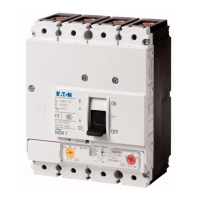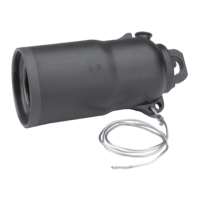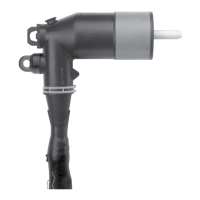7. Place the CONTROL FUNCTION switch in the AUTO/
REMOTE position. After the time delay period, the
control should cause the regulator to step up to the
lower band edge. This will display on the LCD panel.
Example: 120 V and a 2 V bandwidth = 119 V lower
band edge.
Control bench testing
When applying external voltage to a CL-7 control,
disconnected from the control box back panel, follow these
steps:
1. Place a jumper between positions 7 and 8 of the
disconnect plug on the wiring harness of the control.
2. Place a second jumper between positions 6 and
terminal G of the disconnected plug. There are two G
terminals on the harness plug. The jumper would be
placed into the G terminal with a wire connected to the
other side.
3. Connect the external source to the external source post
on the front of the control. Connect the hot lead to
the black terminal post, the neutral to the white post,
and the ground to the green terminal post. Refer to
Section1: Control Front Panel: Connecting power to
external source terminals for detailed instructions on
applying power to the external source terminals.
ote:N For a multi-phase control, this method will
only enable powering of the main control. It is
recommended to install the control into a control
box to fully power a multi-phase control using the
external source terminals.
Field calibration check
To check the calibration of the control, compare the voltage
that the control reports on the display to the voltage
measured at the test terminals.
ote:N Field calibration checks are only an indication of
calibration and are not as precise as the procedure
described in Section 8: Troubleshooting.
1. Connect an accurate true-RMS responding voltmeter to
the voltmeter terminals.
2. Use the keypad to access FC 47 parameter. Key in:
FUNC, 47, ENTER.
Or access via the menu: FEATURES > Calibration >
Voltage Calibration.
3. Under ideal conditions, the displayed voltage of
the control will match the voltage of the voltmeter.
Realistically, the voltages may be slightly different
because:
a. The metering and operation is based upon the RMS
value of the fundamental power line frequency.
Thus, the metered values exclude the influences of
harmonic voltages which are probably present on the
line. A true RMS meter, however, will include these
harmonic voltages in its calculations of the RMS
voltage. This does not present a problem with either
metering device, since each device uses a different
approach to metering.
b. The calibration of the voltmeter being used for
measurement is probably not exact. Even a very
good meter with a basic accuracy of 0.5% could
be in error by as much as 0.6 V (out of 120 V) and
still be considered to be “in calibration.” The control
is calibrated using a conditioned power supply
and reference voltmeters which are periodically
calibration-checked, traceable to the National Bureau
of Standards.
ote:N The control firmware is designed to perform ratio
correction. Through the use of the ratio-correction
transformer (RCT) located on the back panel, the
voltage brought to the control is usually corrected
to the 120V base voltage. However, there are some
ratings in which this voltage is not fully corrected by
the RCT. Refer to the regulator nameplate for specific
information for that regulator. Table5 gives a general
indication of these voltages.
When mounting the CL-7 control into an existing enclosure,
the existing enclosure may not have an RCT installed. In
this case the voltage measured on the voltmeter terminals
may not match the voltage read on the control.
Whatever voltage results from dividing the nominal
system voltage, FC 43, by the overall PT ratio, FC 44,
is considered by the control to be the nominal voltage.
Therefore, when that voltage appears at the input of the
control, 120 V will be reported as the output voltage, FC
6, whether the nominal is actually 120 V or not. Likewise,
the compensated voltage, FC 8, and input voltage, FC
7, will be scaled accordingly. If the regulator is equipped
and programmed for reverse power operation, the
compensated voltage will be correct even during reverse
power conditions.
Also note that the base voltage can be set to a 240 V base
using FC 148. When this is done, all secondary voltage
displays will also be scaled to correspond to the 240 V
base. Despite the displays however, the control itself is still
powered using an approximate 120 V input.
The load voltage, FC 10; source voltage, FC 11; and
calculated parameters such as the kVA, kW, and kvar, are
not scaled similarly to FC 6 and FC 8. Instead, they reflect
the true value of line voltage.
ote:N The voltage measured at the test terminals during
reverse power flow is the new source voltage at the
load bushing of the regulator.
16
INSTALLATION, OPERATION, AND MAINTENANCE INSTRUCTIONS MN225003EN April 2018
CL-7 Voltage Regulator Control

